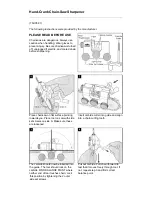
16
OPERATING INSTRUCTIONS___________________________________________________________________________
8.
If the load current exceeds the preset current limit, the
CONSTANT CURRENT indicator will light. In this case, the
power supply automatically switches to the constant current
mode and further rotation of the VOLTAGE control will not
increase the output voltage.
Setting Current Limit
1.
Determine the maximum safe current for the device to be
powered.
2.
Temporarily short the (+) and (-) terminals of the power
supply together with a test lead.
3.
Rotate the
VOLTAGE
control away from zero sufficiently
for the
Constant Current
indicator to light.
4.
Adjust the
CURRENT
control for the desired current limit.
Read the current value on the mA meter.
5.
The current limit (overload protection) has now been
preset. Do not change the
CURRENT
control setting after
this step.
6.
Remove the short between the (+) and (-) terminals and
hook up for constant voltage operation.
Typical Constant Current Operation
1.
Before connecting the device to be powered to the power
supply, determine the maximum safe voltage to be applied,
set the A/B Meter s election switch to the A (up) position, and
set the VOLTAGE control to obtain that voltage reading on the
Volt meter.
2.
Determine the desired constant current value.
3.
Set the CURRENT control to minimum (fully
counterclockwise).
Figure 4. Typical constant voltage operation
4.
Turn off the power supply and connect it to the device to
be powered.
5.
Turn on the power supply. The CONSTANT CURRENT
indicator should light.
6.
The current can be read directly on the mA meter.
Summary of Contents for 1651A
Page 54: ...50 Figura 1 Controles e indicadores del panel frontal...
Page 57: ...53 Figura 2 Controles del panel trasero...
Page 60: ...56 Figura 3 Posibilidades de conexi n a tierra en operaci n independiente 1 de 2...
Page 61: ...57 Figura 3 Posibilidades de conexi n a tierra en operaci n independiente 2 de 2...
Page 65: ...61 Fig 8 Posibilidades de conexi n a tierra en la operaci n de rastreo en serie 0 48V 1 de 3...
Page 66: ...62 Fig 8 Posibilidades de conexi n a tierra en la operaci n de rastreo en serie 0 48V 2 de 3...
Page 69: ...65 Fig 9 Posibilidades de conexi n a tierra en operaci n de rastreo en paralelo 1 de 2...
Page 70: ...66 Fig 9 Posibilidades de conexi n a tierra en operaci n de rastreo en paralelo 2 de 2...
Page 72: ...68 Fig 10 Posibilidades de conexi n a tierra para la fuente fija de 5V 1 de 2...
Page 73: ...69 Fig 10 Posibilidades de conexi n a tierra para la fuente fija de 5V 2 de 2...
















































